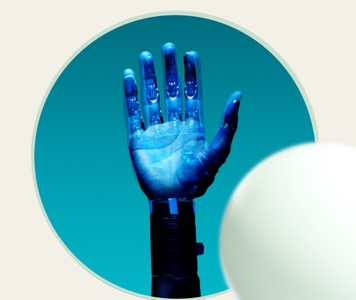We innovate by starting with the customer and working backwards. That becomes the touchstone for how we invent.
Bezos’s quote above encapsulates what companies are trying to achieve today - putting their customer first. Some companies do it well, some not so much.
Remember the famous story of how Apple revolutionized the mobile industry? It was a time when mobile manufacturers were competing to make the fastest phones, the loudest speakers and the coolest keyboards. It was a time when phones looked like this:
But, look at how the iPhone differs from them all - a simple, rectangular glass object amongst a pile of oddly-shaped devices. It was an initial indication of everything Apple stands for - less is more.
Instead of making more and cooler new features, Apple simply disregarded this approach to phone making. Instead of looking at the current competitive set and asking “how can we make a phone that’s a bit cooler than the others?” Steve Jobs thought “What job could the mobile phone do for customers?”.
And the answers were much simpler than you might think. People don’t want to just call other people, they want to feel connected to their community and be in touch with what’s happening around them. They don’t want to use a few devices for a few tasks - e.g. writing their notes in a notebook, listening to good quality music on their CD player or getting their big Canon camera to take good pictures.
The iPhone set out to deliver a full-fledged mobile experience, not another cell phone.
And as we explore what it means to be customer-centric, a useful framework to employ is Jobs-to-be-Done.
What is a Job-to-be done?
The JTBD theory is driven by one phenomenon - people are inherently looking for ways to improve themselves. The purpose of a product (or it’s job to be done), then, is to help them to achieve that goal.
Alan Klement, one of the many spokespeople for the jobs to be done framework defines it as this:
A Job to be Done is the process a consumer goes through whenever she aims to change her existing life-situation into a preferred one, but cannot because there are constraints that stop her.
A “job”, therefore, is a task that customers want to accomplish in a given circumstance. Clayton Christensen, the late Harvard Business School professor and one of the first people to introduce the JTBD framework, notes that “jobs” have a social and emotional dimension and tap into anxieties and needs that consumers may have.
A customer “hires” a product or a new solution to complete that job. If the product completes that job well the first time and the customer experience was great, then this product will be “hired” again in the future. If the product didn’t fulfil the job, it will be “fired” and another alternative will be chosen.
Why should you use the JTBD theory?
1. You’ll have a deep understanding of your customers’ needs
The reason the JTBD framework works is because it adds another dimension to typical methods of segmenting consumers, like customer personas or competitive analysis.
Let’s imagine you’re Steven and you want to buy a chocolate bar. The fact that you work as a bank consultant and drive a Toyota Camri, doesn’t signal to a brand why you want to buy that chocolate bar. And while it’s good to know Steven’s demographic or segment and his psychographic triggers, this information won’t be enough to better understand why your customer does or doesn’t end up paying for your product.
2. You’ll know how your customer will shop in the future, not just today
How many times have you seen and read articles that say “Top 5 Snacking Trends That You Should Look Out For Right Now”, “3 Ways to Kickstart Your Innovation Process In 2022”, etc.? What makes these kinds of articles less helpful is that they focus on customer behaviours today.
If we return to the example of mobile phones, we can see that’s the type of thinking that a brand like Blackberry was doing - thinking only about today. Apple, in contrast, was thinking about how they could create something new to help their customers progress in the future. Fast forward to 2022, Blackberry announced that they have stopped funding their devices as of January 4th.
Compared to other innovation theories, the JTBD framework will help you forecast your customers’ shopping behaviour in advance. Once you know your customer’s job, you’re unconstrained by what’s happening in the category now. You can make innovative decisions that will drive change years ahead of time.
3. You’ll be confident that your product meets customer needs
Back in the 1990s Bob Moesta, an innovation specialist, was approached by a Detroit-based building company that was looking to boost sales for their new condo building. They’d done market research, built top-notch apartments, launched extensive marketing campaigns - nothing helped bring the sales up.
After conducting a few interviews with existing condo buyers, Moesta noticed that the dining table was often mentioned in conversations - it was both considered a point of anxiety (“How do I move my clunky dining table here?”) and of utmost importance (“I felt relieved once I found a place for my dining table”). After some thought, Moesta concluded that the dining table was a place that represented family for many customers.
With that in mind, the building company reinvented its innovation and product development process. They built bigger spaces for dining tables and dining rooms, launched new services to move furniture into the condo - all to help customers feel assured that their dining table issue wouldn’t be an issue any longer.
That’s the beauty of the JTBD theory. Instead of building something that your customers don’t want, you make new products that fulfill their desired outcomes.
Who JTBD theory is for
1. Marketers
If you’re a marketer looking for a way to make your product shine, JTBD can help you on many levels. Firstly, it’ll give you a sense of direction to connect your product to the specific job your target audience is trying to achieve.
Along the way, you might even find out that the audience you were planning on targeting is actually quite different than you’d assumed. This is a good opportunity for you to select the market that will find your product most valuable.
Once you know that your product speaks to customers’ needs, you can begin adjusting the branding strategy, so that it translates the benefits your product brings to complete the job.
Finally, you can follow the JTBD framework to create an effective messaging hierarchy and make sure that all of your product elements (packaging, new features, promotional materials) tell your customer about the importance of your product, both practically and emotionally.
2. Product managers
Clay Christensen mentions in his article in Harvard Business Review that one of the benefits of the JTBD framework is that it can guide innovation processes.
Your product team can use JTBD to decide which products they will release in the future, and importantly, in which order. They can also plan new features and upgrades and choose the best plan of action for product development.
JTBD can help product managers to discover products that will create a great user experience for the right groups of people.
3. Pretty much anyone involved in making and selling a product
It’s important to know that the JTBD theory can be applied to many teams. Whether you’re a salesperson, a customer experience manager or CEO of the whole company, you will find value in knowing what job your customer is trying to hire your product to do. This knowledge will help you save time and resources, as well as make your offering more distinct and compelling to your target audience.
The jobs to be done theory is vast
Business professionals and marketers are still exploring the JTBD framework and how it can be used in practice. What this means is that many aspects of this theory are still being discovered, changed, and debated. But since so many companies are adopting it as part of their strategy work, it makes it even more exciting to see where these brands will be ten, fifteen, and even a hundred years from now.
If you want to learn more about jobs to be done, there’s plenty of resources you can use. Here are some that we helped inform our team and this article:
Know Your Customers’ “Jobs to Be Done” by Clayton Christensen, Taddy Hall, Karen Dillon, and David S. Duncan
Jobs to be done: Theory to Practice by Anthony W. Ulwick - he’s Founder of the innovation consulting firm Strategyn, pioneer of Jobs-to-be-Done Theory, creator of Outcome-Driven Innovation
JTBD.info - a Medium blog ran by Alan Klement, one of the practitioners and developers of the JTBD framework




